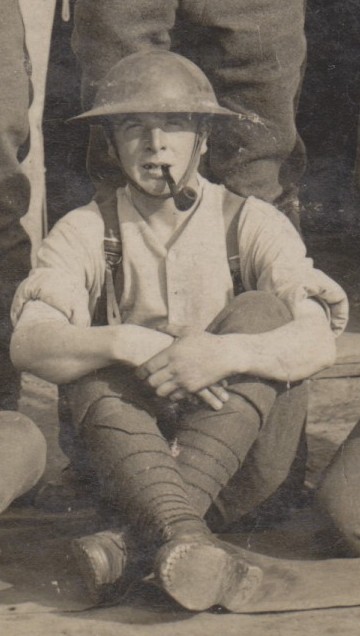
This story was submitted by Mr Johnson of Richmond, he is the grandson of John Ramsden.
John was born in East Ardsley, Leeds. He was called up in 1917 and trained at Chelmsford. He was posted with the 6th Battalion, Durham Light Infantry as 78916 Pte J Ramsden. John kept a diary during his time away from home. On 6th February 1918 at Passchendale Ridge he recorded “Shells are whistling menacingly overhead, I hope my God will give me the strength to withstand the trials that beset me!”
21st March 1918 saw the last big German attempt to win the war. John’s diary reads, “Found a fellow I’ve seen very often laid out of the trench – grim and bloody – ah, yes but smiling in death”.
John was wounded on 28th March and was evacuated to Rouen with other casualties. On 31st March he wrote, “The Doc prodding my head with an instrument much like a pair of sugar tongs. Eventually succeeds in extracting a small piece (but quite big) of the product of Essen”.
After recovering, John was sent back into the line in late May. Again he was hospitalised, this time in an American hospital, taking a serious wound to the hand. The family always believed that the different approach taken by American surgeons saved John’s hand from amputation.
John survived the war and moved to Barnsley, running the local cinema and writing a column for the Barnsley Chronicle.
Explore more memories from the ribbon
-
George and Gertrude Laws, and their children
Submitted by Mike Crisp. Private 47165 George Laws was by trade a painter and decorator from the small market town of Beccles, Suffolk. He joined the 22nd Battalion, Northumberland Fusiliers (Tyneside Scottish) and served in France. On the opening day of Operation Michael, 21st March 1918 his battalion was in the front-line trenches around St Leger / Bullecourt where he was reported missing. His body was never recovered, and he is commemorated on the Arras memorial. According to the battalion diary they suffered 1,130 casualties on that day. George’s wife Gertrude, was heartbroken and never gave up hope of her husband being found, writing to the War Office on several occasions to try and gain more information. It was not until many months later friends of George visited her to relate that George was a member of a bombing party which went to a flank and were never seen again. Not only was Gertrude in mourning but also on the poverty line, forced to bring up 2 small children on her own. To help make ends meet she took in washing, sat with the dying, and laid out corpses for the local undertakers. Her son became the surrogate ‘man of the house’ and it was not until 1968 that he felt that he could leave his mother to get married himself. Gertrude died at the age of 97 in 1977.
-
Cpl W G Padden
Anthea Dunne dropped into the museum with a photo of her father (pictured in the centre of the group), and after a little research she has managed to piece together the story of his service during the First World War. William George Samuel Padden was my father from Pontnewydd, near Newport, Monmouthshire, he volunteered and enlisted at Carmarthen in west Wales on 9th October 1914, as part of The Pembrokeshire Yeomanry, the Territorial Force. As a Private in the Pembroke Yeomanry, he was given the regimental number 4390. Although not compelled to, he signed up as willing to serve overseas. He was transfered to 210 Company of the Machine Gun Corps (part of the 4th Dismounted Brigade) on 22nd October 1916 and given the new regimental number 74792. Initially a private in the Machine Gun Corps, he later became a corporal (29th May 1918). In April 1916 he sailed for Alexandria as part of the 4th Dismounted Brigade, fought in Egypt, stationed at Wadi El Natrun for 2 years. By 1917 this brigade had become part of The Welsh Regiment. By May 1918 he was fighting on the Western front in France. He was wounded on September 25th 1918 and sent home to a military hospital in Reading with a fractured right femur. He was finally discharged from hospital on May 3rd 1919 with a 40% degree of disablement and a pension of 12 shillings a week [with a temporary bonus of 20%]. He received a Silver War Badge in…
-
George Ellis
Submitted by Pauline Blewis. George was born in Old Malton and joined the Green Howards in around 1905. In the same year he married Annie Hemstock, a Richmond girl. Their family of three sons and a daughter were raised in the barracks, now the Garden Village. George served during the Boer War and during the First World War was transferred to the 13th Battalion (October 1915)- the battalion was made up of ‘Bantams’. George served through the war up to the Battle of Cambrai. On 23rd November 1917 he was sent up to the front line with his battalion with the aim of taking Bourlon Wood and village. Tanks were sent in with the infantry following up, eventually the village was taken after hand to hand fighting. George died during this advance and while his body was never found his name is inscribed on Panel 5 of the Cambrai Memorial. After his death the family were moved from the barracks into a house inside Richmond Castle.
